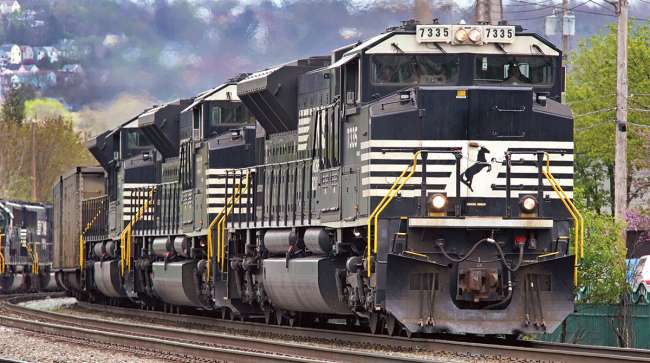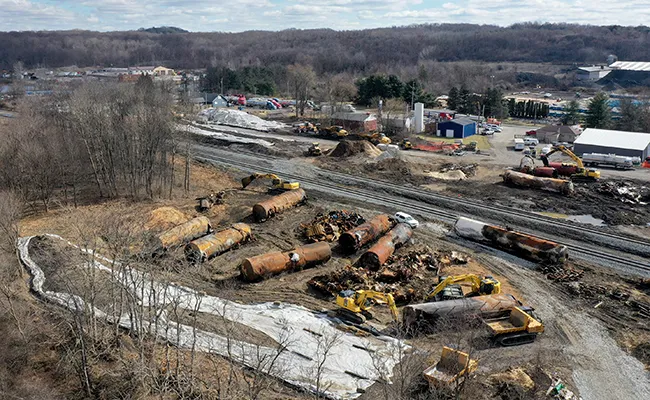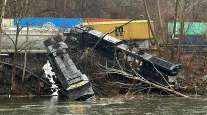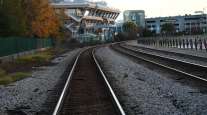Senior Reporter
Ohio Derailment Cost Norfolk Southern $387 Million

[Stay on top of transportation news: Get TTNews in your inbox.]
Norfolk Southern announced April 26 that the Feb. 3 freight train derailment in East Palestine, Ohio, cost the Class I railroad $387 million, which impacted its first-quarter profit by 33.7% when compared with the same period a year ago.
Atlanta-based Norfolk Southern’s quarterly income was $466 million, or $2.04 a share, compared with $703 million, $2.93, in 2022.
Norfolk Southern said first-quarter revenue in 2023 was up 7% to 3.1 billion, compared with $2.91 billion.
Without the charge for the derailment, the railroad said income from rail operations would have totaled $1.1 billion in the quarter, comparable to a year ago.
Today we announced our first quarter results, including updates on our progress in East Palestine, safety initiatives, and strategy for serving our customers.
More details: https://t.co/rZUBxf1cft pic.twitter.com/nXYOfi090B — Norfolk Southern (@nscorp) April 26, 2023
“From the beginning, we have been guided by one principle: We are going to do whatever it takes to make it right for East Palestine and the surrounding areas,” CEO Alan Shaw said in the statement. “We are making progress every day and I’m proud of our people. Our response reflects our strategy of focusing on long-term priorities and value.”
Norfolk Southern said most of the charge-off is related to the environmental cleanup in East Palestine and legal proceedings. The company said it expects that figure to grow as the cleanup continues and the charge does not reflect money Norfolk Southern said it intends to recover through insurance.

A view from Feb. 24 of the cleanup of the Norfolk Southern wreckage in East Palestine, Ohio. (Matt Freed/Associated Press)
Norfolk Southern said its insurance coverage begins after it spends the first $75 million on damage to other people’s property and after $75 million to its own property and equipment. That leaves the railroad responsible for much of the coverage of the cleanup, between $150 million and $200 million, and it’s expected that the company and its insurance company will work out the details over the scope of coverage over time.
The railroad is in discussions with the Ohio attorney general concerning the amount of money it will put into paying for the coverage of the long-term health issues and compensation for residents for loss of their property values because of the accident and toxic chemical fire.
Norfolk Southern’s operating ratio lapsed to 77.3 in the first quarter, compared with 62.8 a year ago. Operating ratio measures a company’s expenses as a percentage of revenue and determines efficiency. The lower the ratio, the greater the company’s ability to make a profit.
The accident resulted in dozens of railcars leaving the tracks, including 11 tanker cars that were carrying hazardous materials and caused a fire that burned for several days, just miles from the Ohio-Pennsylvania border.
The National Transportation Safety Board is investigating the incident and the government agency is expected to issue its final report on the cause, as well as make recommendations on improving rail safety later this year or in early 2024.
The NTSB also began a special probe into the railroad’s safety culture, calling out the railroad’s “number and significance” of accidents.
The Federal Railroad Administration is also conducting a safety investigation into Norfolk Southern, and weeks after the accident, Sens. Sherrod Brown (D-Ohio), Bob Casey (D-Pa.), and John Fetterman (D-Pa.) introduced the Railway Accountability Act, which they say will improve rail operations and prevent future derailments.
To read more about the Railway Accountability Act visit: https://t.co/KT1QuPZx4s — Senator John Fetterman (@SenFettermanPA) March 31, 2023
The state of Ohio sued the railroad operator in March, seeking compensation for damages to the state’s environment, economy and residents.
The stretch of track where the accident took place is part of a major east-west rail line for the railroad, carrying freight between Chicago and the East Coast.
Shaw confirmed the cleanup at the derailment site is ongoing and impacting its operations, running with only one temporary track and running trains at a lower speed. He said the double track should be restored and operational in early June.
“We are a safe railroad,” Shaw told reporters and analysts on a conference call. “We strive to do better. We are going to learn from this accident to become an even safer company.”
As a result of the accident, Norfolk Southern said its average train speed in the Eastern U.S. in March fell to 19.5 mph as it made changes in the way it assembles freight trains. At the end of 2022, Norfolk Southern trains were traveling 20.7 mph. Along with the other Class I railroads, Norfolk Southern said it is working to improving safety, including the installation of more than 1,000 track-side detectors that measure the temperature of a freight rail car’s wheels, which can detect a problem before a derailment takes place.
Want more news? Listen to today's daily briefing above or go here for more info
However, the railroad’s labor unions say even before the pandemic, the railroads were cutting jobs to improve profits at the expense of safety, and during COVID, the railroads continued to cut, leaving trains more vulnerable to high-profile accidents such as the one in East Palestine.
The railroads have said they don’t believe the changes they’ve made have created safety problems and they defend their record as the safest way to transport hazardous chemicals over land.
“Moving forward, Norfolk Southern will be known for safe operations,” Shaw said.




